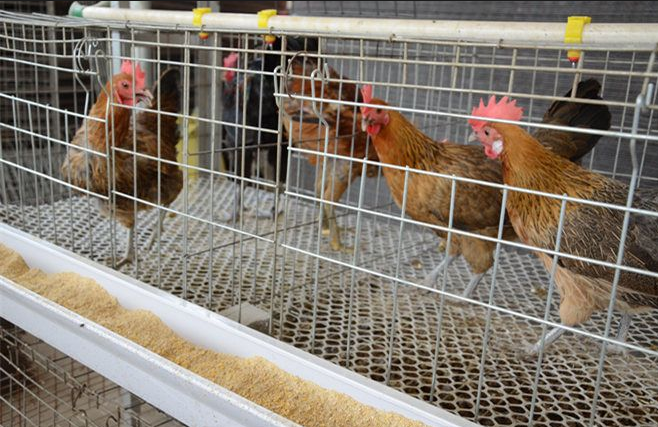Preparation for broiler cages before entering the brood
Jun 11, 2019
In order to successfully complete the brooding plan, all aspects of preparation must be done before brooding. The content includes clear brooding personnel and their division of labor, formulating brooding plans, preparing feed, litter and required medicines, repairing and disinfecting brooding houses and utensils, and formulating immunization procedures.
1 The brooding plan of the brooding plan includes the brooding batch, time, chick breed, quantity and source. The number of chicks in each batch should be consistent with the capacity of the brooding house and the chicken house. Can not blindly enter the chick, otherwise the number is large, the density is high, resulting in poor development of the flock and increased mortality. The number of chicks is determined by the amount of new hens in the current year. The general calculation method is: number of chicks = number of hens (1 culling rate) ÷ breeding rate × brooding rate ÷ male and female identification accuracy.
2 Selection of the brooding season The brooding season should be based on the production and conditions of the chicken farm. The broiler house is brooded in a closed house. The environment of the house is completely controlled by the hand. The brooding is not affected by seasonal climate changes and can be carried out all year round. However, in open house, because the environment cannot be completely controlled manually, the appropriate brooding season should be selected. Different seasons make the environment of chicks different, which has an impact on the growth and survival rate of chicks and the laying performance of adult chickens. The vast majority of farmers raise chickens in open-type chicken houses, so it is very important to grasp the brooding season.
Brooding can be divided into spring chicks (3-5 months), summer chicks (6-8 months), autumn chicks (9-11 months) and winter chicks (12-February). Practice has proved that brooding in open house has the best effect in spring brooding, followed by brooding in winter and autumn, and the worst in brooding in summer. However, at present, many chicken farmers aim at the market, adopting winter and autumn brooding, and have obtained good economic benefits.
3 repair of the house and equipment In order to obtain better brooding results, we must first choose a brooding house. The basic requirements of the brooding house are: good insulation, proper ventilation and ventilation, so that the air in the house is fresh and dry, the light is sufficient, and the strength is moderate. Before brooding, a comprehensive inspection of the brooding house should be carried out. The damaged and leaking places should be repaired in time, and a wind bucket should be left in the corner of the window for ventilation. The mouse hole should be tightly sealed, and the illumination of the lamp should be even (the incandescent lamp should be 4060 watts). Brood cages, insulation equipment (such as stoves, heating, electric umbrellas, etc.) should be prepared in advance, and utensils, drinking fountains and other utensils should be prepared to ensure that the chickens eat and drink at the same time. Equipment and appliances can be put into service after inspection and confirmation of normal or repair.
4 brooding houses and equipment disinfection brooding houses and all equipment in the house should be thoroughly cleaned and disinfected before entering the nest. First clean the brooding house, the wall and the flue can be disinfected with 3% gram of Liaolin solution, then use 10% lime milk to brush white, the mud surface should be shovel a layer of topsoil and replaced with new soil, the cement floor should be fully brushed, then Spray disinfection with 2%-3% sodium hydroxide solution. The trough and drinker can be disinfected with 2%-3% hot kelaolin emulsion or 1% sodium hydroxide solution, rinsed with water and dried in the sun for use. If the brooding house has good sealing performance, it is best to use fumigation disinfection, put the dried brooding utensils into the brooding house, seal all the doors and windows, and use formalin ML and potassium permanganate per cubic meter of brooding house. For a dose of 7.5 grams, put potassium permanganate into the ceramics, then pour the formalin (the volume of the ceramic is more than 10 times the amount of formalin to prevent the liquid from overflowing). A large amount of smoke will be generated immediately and the staff should evacuate quickly. Spray some water on the ground in advance to increase the humidity of the air to enhance the disinfection of formaldehyde. Close the door and window for more than 24 hours to ventilate, switch to fresh air and then close it for use. The disinfected chicken house needs to be idle for about 7 days before entering the chick.
5-floor padding and netting, cage installation Ground brooding requires enough high-quality bedding to provide a comfortable and warm environment for chicks. The litter is required to be dry, clean, soft, absorbent, and less dusty. Do not use mildew or damp padding. Commonly used litter materials include straw, wheat straw, sawdust and the like. Long litter should be cut short before use, about 10 cm. When brooding on the net, it is best to first weld a 50-60 cm high bracket on the concrete floor of the house, and then lay a solid frame of iron mesh on the upper end of the bracket, generally 2 meters long, 1 meter wide, and 1.25 cm x 1. 25 cm. The framed wire mesh piece should be firmly and evenly placed on the bracket and easy to handle. After the mesh is installed, the bottom mesh is surrounded by a nylon mesh or wire mesh with a height of 40-45 cm. There are two types of brooding cages produced in China: semi-stepped and stacked. The brooding cage should be installed in the house before brooding and used for disinfection.
6 Preparation of feed and medicine equipment Before brooding, the feed must be prepared according to the nutritional needs of the chicks, or the commercially available chicken feeds should be purchased. Each broiler should be prepared with 1.2-1.5 kg of ingredients. Before brooding, you need to prepare commonly used drugs, vaccines, and instruments, such as disinfectants, antibiotics, anticoccidial drugs, anti-white peony drugs, multivitamin preparations, trace element preparations, and vaccines and syringes for epidemic prevention.
7 The arrangement of the brooder requires the brooder to be familiar with and master the technical operation rules of the breed, to understand the growth and development rules of the chick, to identify the disease and to master the disease prevention and control methods. Brooders should prepare a variety of record forms.
8 Pre-warming of the brooding house 2 days before the brooding, the brooding cage and brooding device should be installed, and the preheating and temperature testing work should be carried out to meet the standard requirements, and the temperature can be checked to adjust in time. If the ground level is adopted, the thermometer will be hung at 5 cm from the litter, and the temperature change in the house will be recorded. The night temperature is 3290 and the daily temperature is 319C. After 2 days and nights of temperature measurement, the chickens can be placed for feeding after meeting the requirements.
Pre:Broiler chicken cage chicken feed mixing method
Next:Selection of Chicken Breeding Methods in Chicken Cage

